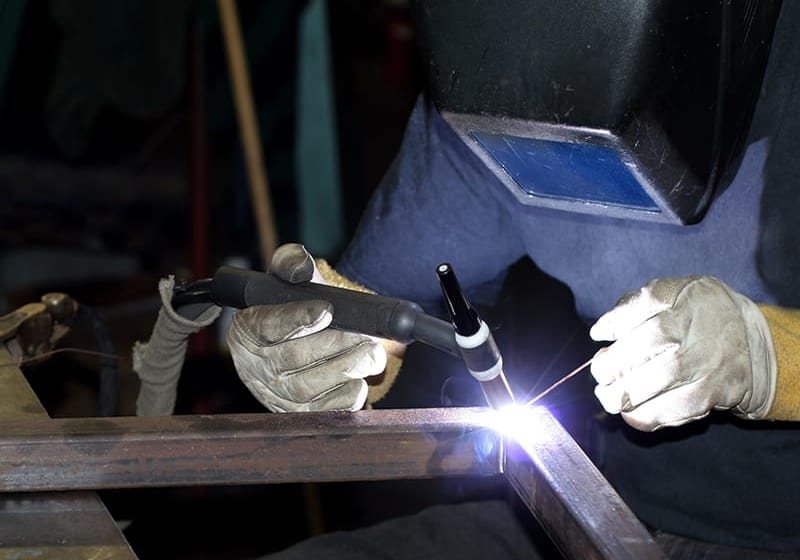Argon is a colorless, odorless, and tasteless gas that accounts for 0.93 percent of the Earth’s atmosphere. It is also regarded as a noble gas since it does not react under any circumstances.
Argon welding is widely used by both industrial and home welders, and argon and its blends are primarily employed in two welding processes- shielding and purging.
TIG welding requires a shielding gas that is completely inert at welding temperatures, and pure Argon meets that requirement. Argon is also a frequently used gas in the purging process, which is essential for TIG welding stainless steel and other corrosion-resistant metals.
Why is argon important in welding?
Welding work requires argon because of its inexpensive cost, shielding gas characteristics, and stability. It does not react with other elements and does not explode into flames when exposed to the high temperatures required for welding.
Because of its natural abundance in the Earth’s atmosphere, it is also a cost-effective gas alternative for welders.
Two main reasons why welders prefer argon while TIG welding steel-
First, argon is a non-flammable gas that does not burn. With temperatures surpassing 7000 degrees Fahrenheit, it is a safe alternative for welders.
Second, aside from being non-flammable, argon is also nontoxic. However, there are certain health risks associated with the use of argon. Employing argon reduces the amount of oxygen in the air. This is ideal for arc welding, however, it puts the welders in danger.
Now let us understand the benefits of argon
1.) Argon is inert but readily available.
Argon is an inert gas, however unlike the other gases, argon is easily available.
This gas is the third most abundant in the Earth’s atmosphere and may be extracted by liquifying air. The method may appear difficult, but it is far easier than the procedures used to create other gases such as helium.
Argon is neither poisonous or flammable due to its noble properties. As a result, it is a generally safe choice for welding operations.
2.) Argon produces cleaner, tougher welds.
Argon welding gas produces both functional and aesthetic effects due to its steady arc.
Argon’s shielding function shields the welded puddle from defects by preserving the material’s structural integrity.
Similarly, Argon keeps your welded seams appearing good by preventing carbide development, excessive spatter, discoloration, and a variety of other aesthetic flaws.
3.) It does not react with other gases.
Argon is a noble gas, which means that it does not react with other gases.
Helium, neon, xenon, radon, and krypton are also members of the noble gas group. Because they do not easily combine with other elements or compounds, this exclusive category is sometimes known as ‘inert gases.’ Indeed, the definition of inert is ‘chemically inactive.’
4.) Argon forms a stable arc.
Because Argon is a stable gas with no ionisation potential, the current employed for arc welding would have a constrained course.
This enables argon to produce a more focused and steady welding arc, which enhances penetration. Argon’s poor heat conductivity is another advantage.
This welding gas has a decreased heat transfer rate outside of the high temperature of the weld pool and maintains the heat focused, which improves the welding arc’s stability.
While Argon is incredibly beneficial in both TIG and MIG welding applications, there are numerous situations where it would not be appropriate to use it alone.
Therefore, let us look at some various forms of argon and its blends that are utilised in various welding techniques.
1.) 100% Argon
When welding nonferrous metals such as aluminum, copper, and nickel, pure argon, that is 100% argon is utilised. Pure argon is also the preferred gas for TIG welding.
Pure argon not only protects the weld from contamination, but it also prevents tungsten oxides from developing on the tungsten electrode.
2.) Argon and carbon dioxide
Argon and CO2 mixtures are the most often utilised gases in shield welding. These mixtures are made up of 80-95 percent argon and 5-20 percent CO2.
This mix, with its greater carbon dioxide levels, provides the highest overall performance in terms of completed weld aesthetics, arc stability, and broader penetration shape.
To promote weld penetration, the amount of CO2 is increased in proportion to the thickness of the welding material. Increasing the CO2 level of the gas mixture increases the possibility of spatter.
These mixtures are most commonly used for carbon steels, low alloy steels, and some stainless steels.
3.) Argon and Helium
Argon and helium blends are divided into two categories-
90% argon-10% helium– The increased heat input from the helium offers the weld puddle remarkable fluidity and enhanced arc stability.
This would give you an amazing aesthetic while also allowing you to boost your welding speeds.
The use of helium allows for deeper weld penetration, a flatter bead profile, and the ability to TIG weld at increased levels.
75% argon-25% helium– For cases involving thicker weld joints of non-ferrous materials such as aluminum, a 75% argon mix is the optimum choice.
Because aluminium has a high heat conductivity, the machine must produce a large amount of current to offset the cleaning effect of the alternating current.
It allows for faster welding speeds and decreases oxides and heat-affected zones in the finished weld while maintaining the deep penetration profile.
4.) Argon and oxygen
Argon and oxygen are another typical sort of combination. These mixtures include 95-99% argon and 1-5% oxygen.
Argon-oxygen mixtures are utilised to generate a consistent welding arc and minimal amounts of spatter in carbon and stainless steel metals.
Then there are tri-mix gas blends, which is a combination of 3 different gases that are combined to form a shielding gas.
5.) Tri-mix gas compositions are accessible in various of combinations, including:
-
-
- 90% helium, 7.5% argon, and 2.5% carbon dioxide.
- 66% argon, 26.5% helium, and 7.5% CO2.
- 66.1% argon, 33% helium, and 0.9% CO2.
-
These mixtures are used to weld stainless steel, carbon steel, and alloy steel.
Things you have to look out for while working with argon
Because argon displaces oxygen, it can induce asphyxia (suffocation) if not employed in a well-ventilated environment.
• Argon can create the following problems if not properly ventilated. It can cause breathlessness, headaches, drowsiness, dizziness, nausea, and even cause death.
• Because argon is held in a pressurised tank at extremely high pressure, rigorous safety precautions and bottle storage are critical.
Before storing the gas, make sure the bottles are securely fastened to avoid them from toppling over and damaging the valve.
• Leaking or broken gauges can introduce pollutants into the shielding gas, or the gas leak might build up to high levels in the work area, depleting oxygen and lowering air quality.
• Almost twice as much argon is utilised while purge welding stainless steel or titanium tubing.
If the welder is welding in a restricted location, the argon builds up to the point where the oxygen levels are dangerously low.
Conclusion
Argon is a shielding gas that is considered one of the most frequent inert gases used in welding.
And because it disperses contaminating materials in the environment and shields welds from oxidation and corrosion, its adaptability, usefulness, and low cost have elevated it to favor among both professional and novice welders.
MIG and TIG welders all around the globe utilise both pure argon and its blends.







